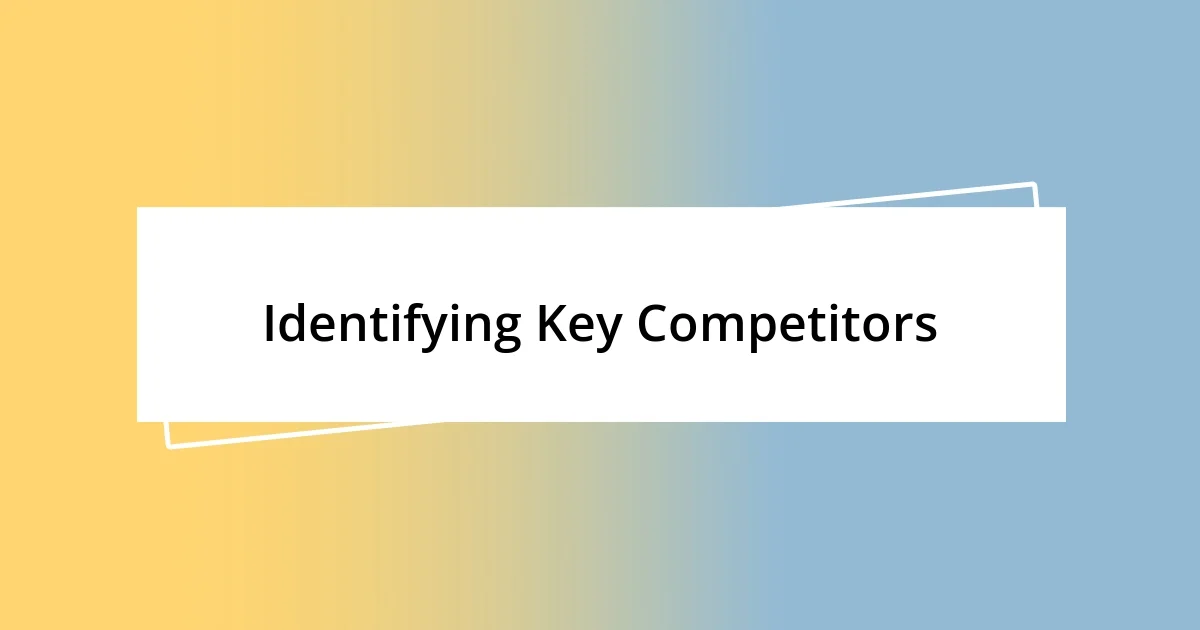Key takeaways:
- Establishing clear objectives for competitor analysis helps in transforming data into actionable insights, ensuring efforts are directed effectively towards strategic goals.
- Utilizing various methods, such as SWOT analyses and customer feedback, allows for a comprehensive understanding of competitors’ strengths and weaknesses, revealing opportunities for differentiation.
- Incorporating insights gained from competitor analysis into marketing strategies—such as personalized communications and interactive content—can significantly enhance audience engagement and improve overall performance.

Understanding Competitor Analysis Goals
Understanding the goals of competitor analysis is essential for driving strategic decisions. I remember when I first embarked on this journey; I was overwhelmed by the sheer amount of data available. But then it hit me—every piece of information should connect to a specific objective, like improving my product or identifying market gaps. What do you want to achieve with your analysis?
Setting clear objectives allows you to focus on what truly matters. For instance, I once aimed to discover why my sales were plateauing. Understanding that my competitors’ marketing strategies were a key factor directed my efforts and gave me the insights needed to adjust my own approach. Isn’t it fascinating how having a clear goal can transform seemingly chaotic data into actionable insights?
Moreover, I found that defining success metrics early on helped measure the impact of my competitive research. Have you ever felt lost in a sea of metrics, unsure of what really matters? By identifying KPIs—like customer acquisition cost or market share—I could gauge the effectiveness of my strategies more accurately. This clarity not only streamlined my efforts but also built confidence in decision-making.

Identifying Key Competitors
When it comes to identifying key competitors, I often start by evaluating both direct and indirect rivals in the market. This is crucial because sometimes the fiercest competition lies outside the obvious players. I remember a time when I focused solely on well-known brands, only to discover a small startup that had innovated in ways my established competitors hadn’t. It was a game-changer for my strategy.
Here are some effective methods for pinpointing key competitors:
– Market Research: Utilize tools like industry reports and market analyses.
– Customer Feedback: Pay attention to what customers say about you and your competitors.
– Social Media Insights: Analyze engagement and brand presence on platforms like Instagram and Twitter.
– Keyword Analysis: Explore which keywords drive traffic to competitor websites.
– Product Comparison: Review how your products stack up against others in terms of features and pricing.
By actively engaging in these methods, I often find fresh perspectives that challenge my assumptions, leading me to unexpected insights. It’s an enriching process that keeps my finger on the pulse of the marketplace.

Gathering Relevant Competitor Data
Gathering data on competitors can sometimes feel overwhelming, but I’ve learned that simplicity is key. Initially, I made the mistake of trying to collect every piece of information available. Instead, focusing on relevant aspects—like pricing, customer reviews, and product features—provided clearer insights and directed my efforts more effectively. Have you ever spent hours sifting through data, only to feel like you didn’t gain any real value? I certainly have, and it taught me to streamline my approach.
One practical example I can share is how I utilized online tools to gather meaningful competitor data. Platforms like SEMrush or Ahrefs allowed me to analyze website traffic and keywords, shedding light on what competitors were doing well. There was a moment when I discovered a competitor was consistently ranking for a keyword I hadn’t even considered. That revelation pivoted my entire content strategy. It’s amazing how the right tools can reveal hidden opportunities!
Lastly, I recommend looking into customer feedback across various platforms. Reading about what customers appreciate or criticize can illuminate key strengths and weaknesses of your competitors. The emotional connection customers have with brands often translates into insights that raw data can’t provide. The last time I did this, I was surprised to find a common pain point among users of a similar product. It felt like uncovering a goldmine of information that I could use to enhance my own offerings.
| Data Source | Description |
|---|---|
| Market Research | Industry reports and market analyses provide insights into competitor positioning. |
| Customer Feedback | Reviews and comments reveal customer sentiments towards competitors. |

Analyzing Competitor Strengths and Weaknesses
Understanding competitor strengths and weaknesses is like peering through a window into their world. One method that I’ve found particularly effective is conducting SWOT analyses—assessing strengths, weaknesses, opportunities, and threats. In one project, I realized that a rival’s strong social media presence wasn’t their only asset; they were also adept at responding to customer inquiries. This ability clearly demonstrated their dedication to customer service, something I had to enhance in my own operations.
When analyzing weaknesses, I often dig into online reviews and customer feedback. It surprises me how much you can learn by simply listening to the audience. For instance, I once came across numerous reviews highlighting a competitor’s frustrating return policy. This was a moment of revelation for me—recognizing that I could position my brand as more customer-friendly. Have you ever noticed how a single flaw can create a gap for your brand to stand out? It’s thrilling to find these opportunities hidden amidst criticism.
Through this process, I also keep an eye on industry trends. I remember reading an article about a shift in consumer preferences towards sustainable products. This triggered a realization about another competitor whose product line lacked eco-friendly options. It was enlightening to see how a competitor’s oversight could translate into a rich, untapped market for my brand. At that moment, I felt not only a sense of urgency but excitement around the possibilities laying ahead. The insights gleaned from these analyses have continually shaped my strategy, making my competitive edge sharper with each review.

Evaluating Competitor Marketing Strategies
Evaluating competitor marketing strategies is a critical step that can reveal both innovative approaches and potential pitfalls. I’ve often looked at how competitors structure their campaigns and allocate resources. For example, I noticed one competitor was making excellent use of influencer partnerships. It made me wonder, could I tap into similar collaborations? This realization nudged me to explore influencer marketing as a way to amplify my brand’s reach.
As I studied various marketing channels, I was fascinated by a competitor’s adept use of social media. They crafted content that sparked genuine engagement, not just likes. I remember feeling a mix of admiration and motivation as I observed their consistent storytelling. It led me to reevaluate my own social media strategy. Could I tell my brand’s story more compellingly? It was during this reflection that I made the conscious decision to infuse more personality into my posts, transforming my social media presence into a vibrant platform for connection rather than mere promotion.
Examining competitors’ promotional tactics has also been a game-changer for me. I once stumbled upon a competitor’s intriguing email campaign that boasted a high open rate. Seeing how they crafted enticing subject lines sparked my curiosity. I asked myself, “What resonates with my audience?” This prompted me to experiment with different approaches, leading to not just improved open rates but deeper connections with my subscribers. This dynamic process of evaluating and adapting strategies is not just about competition; it’s essentially a journey of learning and growth that keeps the marketing landscape exciting.

Utilizing Tools for Competitor Insights
Utilizing tools for competitor insights is an essential aspect of my analysis. I’ve found platforms like SEMrush and Ahrefs to be invaluable for tracking competitor keywords and content strategies. The first time I ran a competitor’s domain through SEMrush, I was shocked at how much keyword data it revealed. I could see not just what they were ranking for, but also what gaps I could fill. Can you imagine the power of pinpointing exactly what your competitor is missing?
In addition to SEO tools, social listening platforms like Hootsuite or Mention have transformed how I perceive audience engagement. By monitoring competitor mentions and customer sentiment, I once discovered that their latest product launch was met with significant backlash regarding quality issues. This insight not only confirmed my belief in the importance of quality control but also highlighted an opportunity for my brand. Have you ever considered what you could learn about your competition’s missteps before making your move?
Lastly, I also appreciate the insights that analytics tools provide on social media performance. I remember diving into Sprout Social to compare engagement metrics, and it was revealing to see how one competitor thrived on Facebook while another soared on Instagram. This realization opened my eyes to the fact that each platform has its own unique audience, and it led me to tailor my content strategy accordingly. It’s remarkable how a single tool can reinterpret the competition’s approach and inspire your next marketing campaign—are you ready to explore the insights waiting for you?

Applying Findings to Improve Strategy
After gathering insights from competitor analysis, I’ve always felt it’s essential to adapt my strategies accordingly. For instance, when I noticed a competitor’s successful use of personalized email marketing, it struck a chord with me. I decided to incorporate more tailored content into my communications—imagine the difference it makes when customers feel like they’re receiving a message just for them. The feedback I received was immediate; my open rates soared as clients appreciated the personal touch.
In my experience, applying findings from competitor tactics can feel like a revelation. I once observed that a rival was excelling in creating interactive content, such as polls and quizzes, which fostered a sense of community. This inspired me to experiment with similar formats. I recall the thrill of watching my audience engage more deeply through these interactive elements, transforming my content into a conversation rather than a monologue. How do you think your audience would respond if you invited them to participate in your content creation?
Of course, integrating these insights isn’t always seamless. There have been times when I’ve tried to replicate a strategy that seemed perfect on paper but fell flat in execution. It made me realize the importance of staying authentic to my brand’s voice while borrowing ideas. This process of refinement taught me to trust my instinct even as I apply competitive insights. Are you ready to take the plunge and refine your approach based on what you’ve learned?














